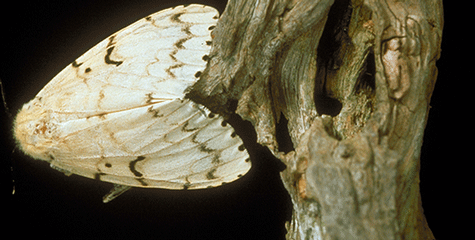Spongy Moth
Spongy Moth
Click below for other insects:
Visual Moth Guide
Visual guide to distinguishing European Gypsy Moth from other defoliating caterpillars.
View Visual GuideThe European Gypsy Moth (EGM) was introduced to Massachusetts from Europe in the late 1800s. Since then it has been spreading and is anticipated to reach Kentucky in the near future. EGM caterpillars eat foliage and, in peak outbreak years, can cause nearly complete defoliation. Because EGM outbreak cycles tend to involve repeated years of heavy defoliation, infested trees become stressed and susceptible to many other abiotic and biotic problems.
What is it?
EGM (Lymantria dispar dispar) adults look similar to many other native, nondescript brown moths. Males are light brown with dark brown markings, up to 1 inch long, and have large feather-like antennae. Females are flightless, white with brown markings, and slightly larger than the males. Females lay eggs in a light orange fuzzy mass.
EGM caterpillars hatch in the spring and feed extensively on a wide variety of host species. Larvae can grow up to 3.5 inches long and are covered with hairs. They resemble several native tent caterpillars however they do not produce tents and have distinctive dots (5 pairs of blue and 6 pairs of orange) along their backs.
What does it do?
During outbreak years EGM caterpillars cause severe defoliation. For example, in 1981 alone an estimated 12.9 million acres of trees were defoliated by EGM. An initial outbreak of EGM usually involves two years of low to medium defoliation, two years of heavy defoliation, and then low levels of defoliation followed by sporadic outbreaks.
Repeated heavy defoliations weaken trees and makes them susceptible to opportunistic insects and pathogens. For example, Armillaria root rot and two-lined chestnut borer, native problems normally tolerated by health trees, can be lethal. Hardwoods are relatively tolerant of defoliation, using energy reserves to produce a second flush of leaves in mid-summer after defoliation, but pines and hemlocks may be more easily killed by heavy defoliation.
European Gypsy Moth Resources:

